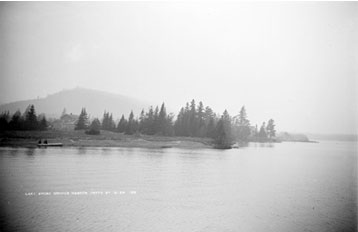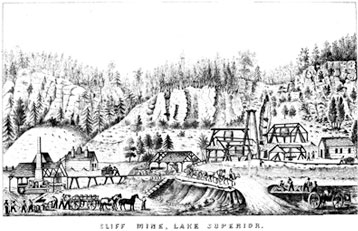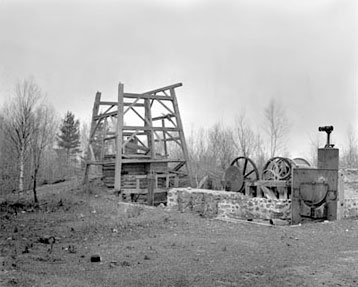A Sense of Place
A photographic essay linking location, community and campus in the Copper Country |
Early Keweenaw
The Keweenaw Peninsula is a remote wilderness, rich in resources, and early industry was extractive. Entrepreneurs came in droves to this area, sparking a Copper Boom in 1843, five years before the California Gold Rush. Early settlements dotted the peninsula; most are gone now and their remains are overgrown and hard to find.

Copper Harbor Lakeshore (Roy Drier)
Roy Drier Photographic Collection
Neg 00147 |
|
Early mining ventures clustered along the rich copper-bearing veins that run the length of the peninsula. It was difficult to travel overland, so people and supplies traveled via ship. Settlements grew first in the northern part of the peninsula. An early view of Copper Harbor represents a first glimpse of the Keweenaw that many ship’s passengers might have experienced in the mid-nineteenth century. |
The Cliff Mine was one of the earliest mining ventures to tap Keweenaw copper veins and, more importantly to its investors, the first mine in the area to show a profit. Established in 1845, the Cliff produced over a million pounds of copper per year at the height of its production in 1863 and paid out almost $1,000,000 in dividends over its productive life. |

Cliff Mine (Foster & Whitney, Copper Lands, Plate IX)
MTU Negative Collection
Neg 02619 |
|

Old Phoenix Shaft 13 (J.T. Reeder)
Reeder Photographic Collection
MS042-062-Z-440 |
|
The Phoenix Copper Company was established originally by the Lake Superior Copper Company, whose investors hoped for an operation as fabulously productive as the nearby Cliff Mine. Producing silver as well as copper, the Phoenix yielded not only the largest single piece of native silver ever recovered from the district, purportedly over eight and a half pounds, but a mass of copper weighing over 500 tons. Early stockholder reports indicate that quite a bit of silver went directly into the pockets of miners and agents. Already abandoned when this photo was taken in the 1920s, the remains of a steam-powered hoist engine and head frame mark the site of one of its shafts. Little more than rubble can be found there today. |
|

